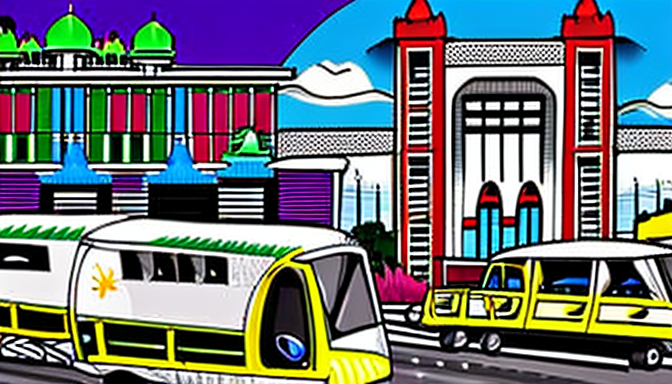Karachi’s story is nothing short of fascinating. Once a humble fishing village, it has grown into one of the largest cities in the world. Can you imagine the humble beginnings of a place that now buzzes with life? The journey of Karachi is like a captivating novel, filled with twists and turns that have shaped its identity.
Let’s take a stroll down memory lane. The city was established in the 18th century as a small port. It was a place where fishermen cast their nets, and traders exchanged goods. Fast forward to the 19th century, and Karachi began to blossom into a major trading hub. The British recognized its potential, leading to the construction of railways and roads. This was a turning point. Suddenly, Karachi was not just a dot on the map; it became a vital link in trade routes.
By the mid-20th century, Karachi was bustling with activity. The partition of India in 1947 brought a wave of migration, transforming the city’s demographics. New cultures and communities merged, enriching Karachi’s tapestry. But with growth comes challenges. Today, Karachi faces hurdles like rapid urbanization and infrastructure strain. Yet, the spirit of its people shines through. Innovative solutions are being crafted to tackle these issues, ensuring that Karachi continues to thrive.
In summary, Karachi’s evolution is a tale of resilience and adaptation. From its modest origins to its current status, the city’s history is a testament to its vibrant character. Each chapter adds depth to its narrative, making Karachi a city worth exploring.
Historical Milestones in Karachi
Karachi’s story is like a colorful tapestry, woven with threads of history that span centuries. It all began as a small fishing village, a quiet spot where the Arabian Sea kissed the shore. Can you imagine? Just a few huts, fishermen casting their nets, and the sound of waves. But then, everything changed.
In the early 18th century, Karachi became a bustling port. This was no coincidence. The British East India Company saw potential here. They established a trading post in 1729, marking the start of a new era. Suddenly, Karachi was on the map. Ships from all over the world docked at its shores, bringing goods and cultures that transformed the city.
Fast forward to the mid-19th century, when Karachi was officially declared a city. This was a major leap! The population surged as people flocked in, seeking opportunities. By the late 1800s, Karachi had developed a modern infrastructure. Roads, railways, and even a postal system emerged. The city was no longer just a port; it was becoming a thriving metropolis.
But wait, there’s more! The partition of India in 1947 brought a wave of migration. Millions poured into Karachi, reshaping its demographic landscape. It was a time of chaos, yet resilience shone through. Karachi adapted and grew, becoming one of the largest cities in the world.
Today, Karachi stands as a testament to its rich history. Each street tells a story, each building echoes the past. The journey from a humble fishing village to a major urban center is nothing short of remarkable. Karachi’s evolution is not just about growth; it’s about the people who call it home.

Modern Challenges and Developments
Karachi, once a tranquil fishing village, now faces a myriad of modern challenges. The city’s rapid growth has transformed it into a bustling metropolis, but this evolution hasn’t come without its hurdles. Imagine a city that grew so quickly, it sometimes feels like a runaway train. With a population exceeding 20 million, Karachi grapples with the pressures of urbanization. The streets can feel like a maze, crowded and chaotic.
Infrastructure is one of the biggest concerns. Roads, public transport, and utilities struggle to keep pace with the soaring population. It’s like trying to fit a giant puzzle piece into a small space. Residents often face long commutes, unreliable electricity, and water shortages. These issues can lead to frustration, but they also spark innovation. Local leaders and communities are stepping up, brainstorming solutions to tackle these pressing challenges.
For instance, the government is investing in public transport systems, such as the Karachi Circular Railway, aiming to ease traffic congestion. Additionally, various NGOs are working tirelessly to improve sanitation and waste management. Here’s a quick look at some of the key developments:
- Public Transport Projects: New bus routes and metro lines are in the works.
- Water Supply Initiatives: Efforts to enhance water distribution and reduce wastage.
- Community Engagement: Residents are encouraged to participate in local planning.
Despite these challenges, Karachi’s spirit shines through. The city’s resilience is palpable. People are adapting and innovating, proving that even in the face of adversity, there’s always room for growth and improvement. The journey continues, and Karachi is poised to tackle its future head-on.
Frequently Asked Questions
- What is the historical significance of Karachi?
Karachi’s history is rich and diverse, evolving from a small fishing village to a major trade hub. Key milestones include its establishment in the 18th century and its rapid growth during British colonial rule, which laid the foundation for its modern identity.
- What are the main challenges Karachi faces today?
Karachi grapples with several contemporary issues such as rapid urbanization, population growth, and inadequate infrastructure. These challenges strain resources and require innovative solutions to ensure sustainable development.
- How has Karachi’s culture evolved over time?
The culture of Karachi is a vibrant tapestry woven from various influences, including indigenous traditions and those brought by immigrants. This dynamic blend creates a unique cultural identity that continues to evolve as the city grows.
- What initiatives are being taken to improve Karachi’s infrastructure?
Various governmental and non-governmental initiatives focus on upgrading Karachi’s infrastructure, including public transport projects, waste management improvements, and urban planning efforts aimed at enhancing the quality of life for residents.